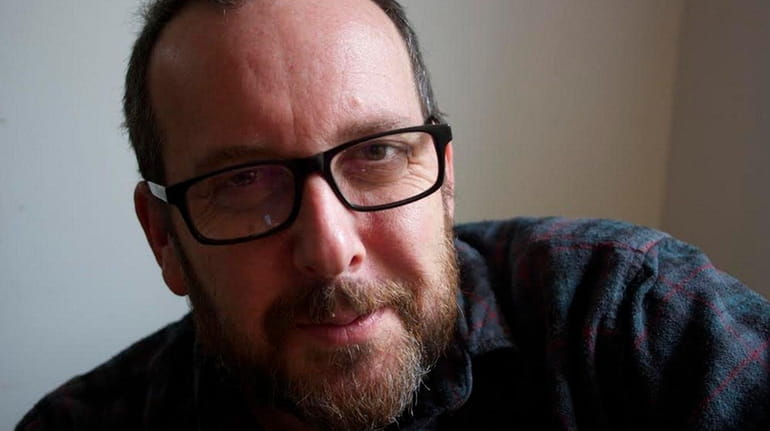‘Better Living Through Criticism’ review: New York Times film critic A.O. Scott defends reviewers

A.O. Scott, author of "Better Living through Criticism." Credit: Carmen Henning
BETTER LIVING THROUGH CRITICISM: How to Think About Art, Pleasure, Beauty, and Truth, by A.O. Scott. Penguin Press, 277 pp., $28.
“What kind of grown man,” asks A.O. Scott, “sits through ‘Kung Fu Panda’ scowling at the screen and taking notes?” Scott would know. More than a decade into his tenure as chief New York Times film critic, he defends his profession in his new book, “Better Living Through Criticism: How to Think About Art, Pleasure, Beauty, and Truth.”
While the title is playful, he means it. Scott, who used to review books for Newsday, aims to rescue critics from public disdain and indifference, to show how vital criticism is to the appreciation and even creation of art. He also wants to get across that being a critic — a good critic — isn’t easy. “You are guaranteed to be wrong — to insult good taste, to antagonize public opinion, the judgment of history, or your own uneasy conscience,” he writes.
In this book, as in his reviews, Scott’s voice is genial, reasonable and self-aware. He elucidates complex ideas with snappy language. He’s funny, but not cynical or snarky.
Criticism, Scott writes, is typically regarded as a “pernicious, parasitic growth on the mighty trunk of human creativity.” In the book’s cogent first half, he traces mockery of critics back to the era of Aristotle and notes that people still think critics killed John Keats. (The tubercular poet may indeed have been fatally enfeebled by two particularly bad reviews.) He reminds us that plenty of great artists were also critics.
As a case study in hostility to critical thinking, he recounts an Internet contretemps that erupted between himself and Samuel L. Jackson over his mixed review of “The Avengers.” (Jackson shot first, tweeting that Scott needed a new job — “one he can ACTUALLY do!”). “In these circumstances,” he writes, “a critic will be guilty of foolishly taking seriously what was only ever meant as harmless, easy fun, or else of dragging something sublime down to his own ridiculous level. But guilty either way.”
Scott’s argument that criticism is “not an enemy from which art must be defended, but rather another name — the proper name — for the defense of art itself” is a stirring rejoinder to such views. What he does especially well is explain how art develops and why our varied responses to it matter, pinpointing where criticism fits into the equation. “All art is successful criticism,” he writes, meaning that artists in every medium respond in some way to art that came before.
In “dialogues” throughout the book, Scott plays his own devil’s advocate, grilling himself on the intricacies of his profession. The back-and-forth gets overly cute, but the commentary is honest and insightful: “Q: So then what you’ve written is a manifesto against laziness and stupidity? A: You could put it that way.” It also loosens up the book’s overall style, which feels at times like a dissertation or an extended think piece.
The book might best be seen as an inspirational cultural-studies primer. Its intended audience seems to be the generation weaned on Amazon reviews, Rotten Tomatoes and Yelp, young people who may be puzzled by the notion of professional criticism in an era when everyone truly is a critic. “It’s a mystery and a horror to me,” Scott writes, “that people are so blindly trusting of aggregated or dubiously sourced opinion.” The common-sensical idea that experienced critics act as much-needed filters for an overwhelming range of cultural options is apparently not so common.
There’s some repetition and beard stroking in the book’s second half. Scott’s insistence that “it is the sacred duty of the critic to be wrong” starts to sound like humblebragging. But he takes dead aim at sloppy criticism: “To call something ‘pretentious’ means you are worried that you didn’t understand it.”
The book concludes on an upswing, with a rapturous discussion of Pixar’s 2007 movie “Ratatouille.” Scott contends that its storyline — a rat becomes a chef, and a fearsome food critic gets fired for extolling the rat’s artistry — ends with the fulfillment of a “Utopian dream”: “that the boundary between art and life — and therefore the uncomfortably aligned, sometimes antagonistic roles of creator, consumer, and critic — will dissolve, along with the distinction between labor and pleasure.”
These words, like many before it, read like a rallying cry for aesthetes. Earlier Scott describes how Rilke’s “Letters to a Young Poet” excited him at an impressionable age, calling it a “touchstone of youthful literary seriousness, a manifesto of artistic integrity.” Despite its flaws, the same may someday be said of Scott’s book.
